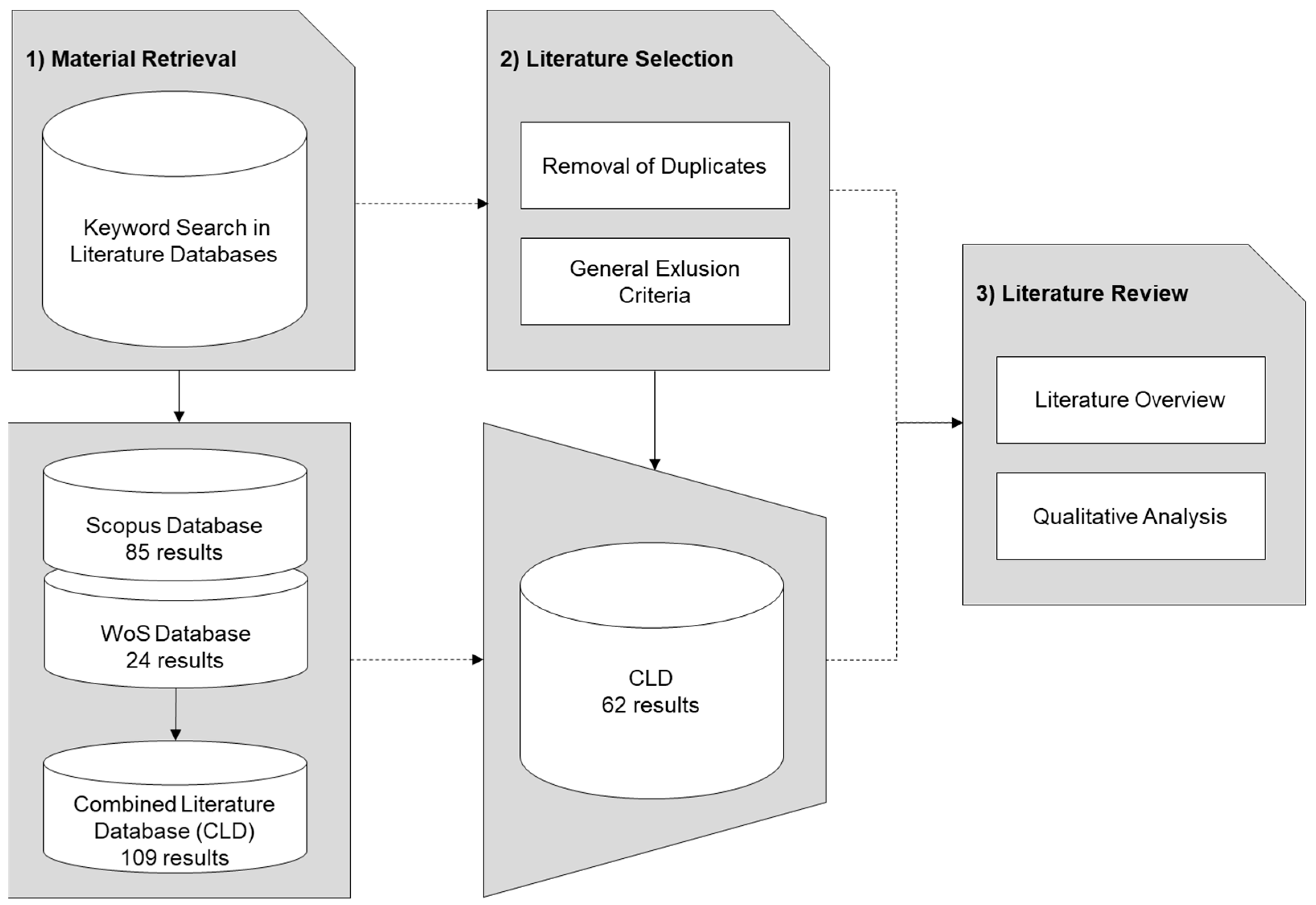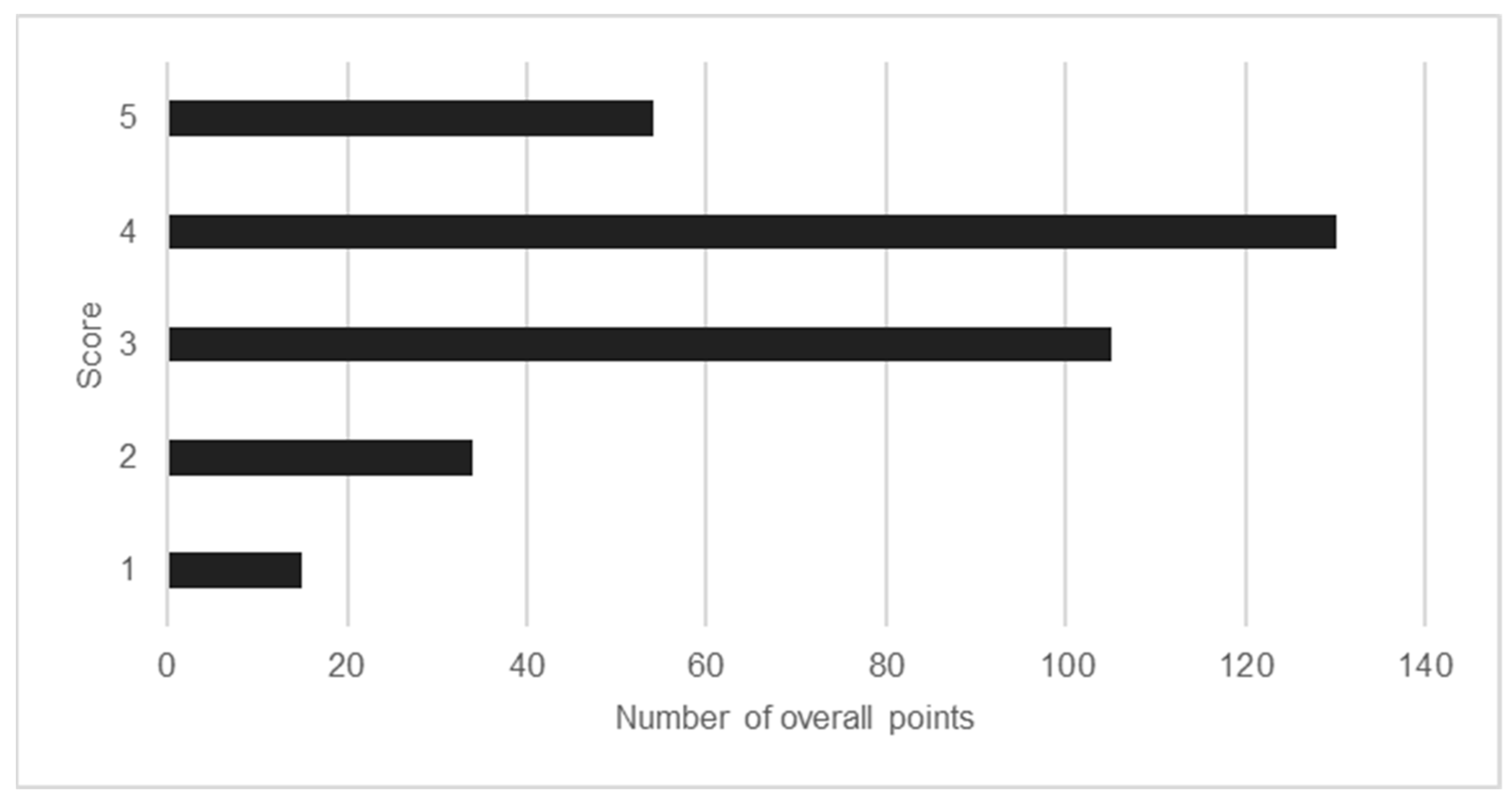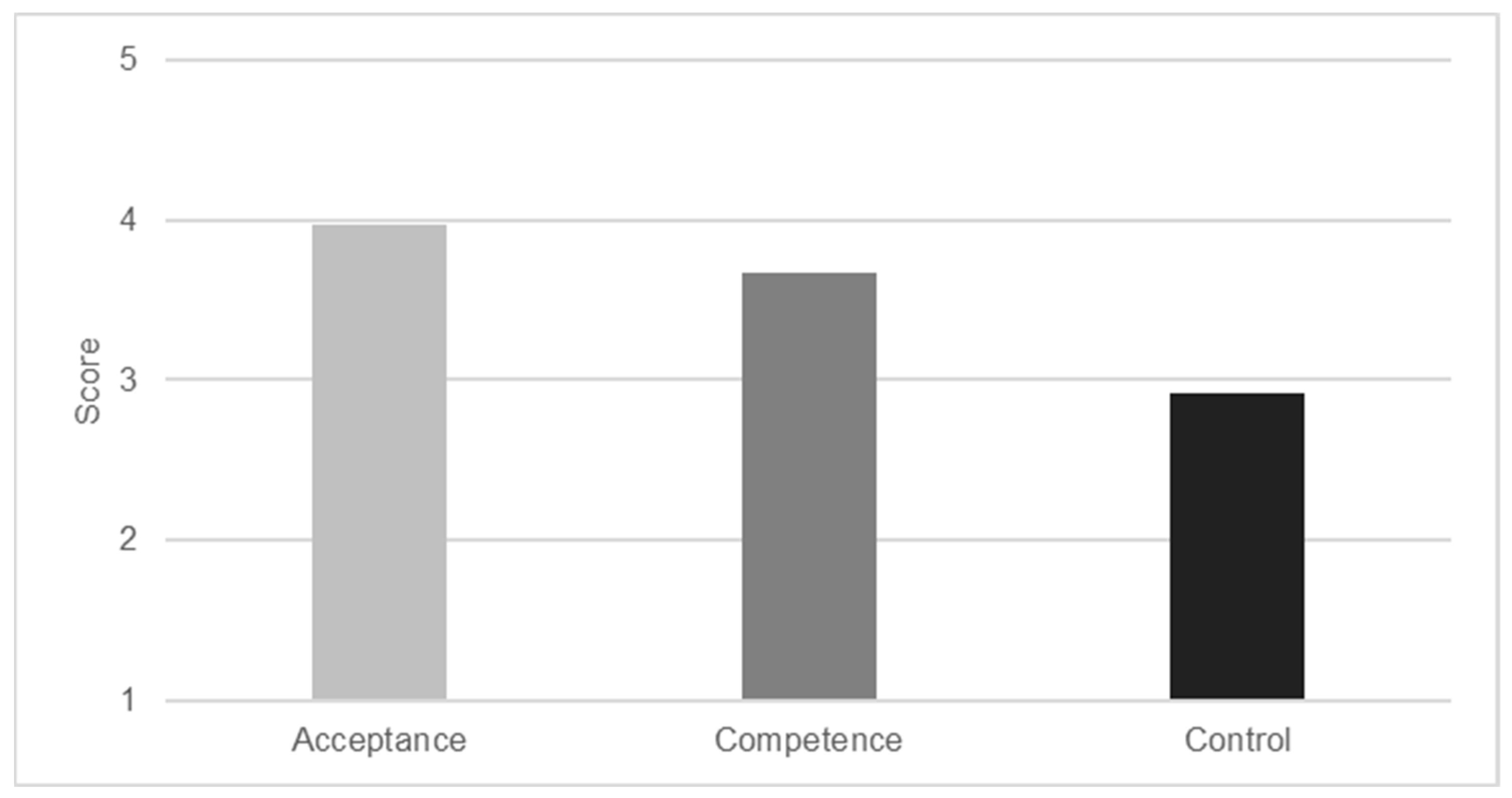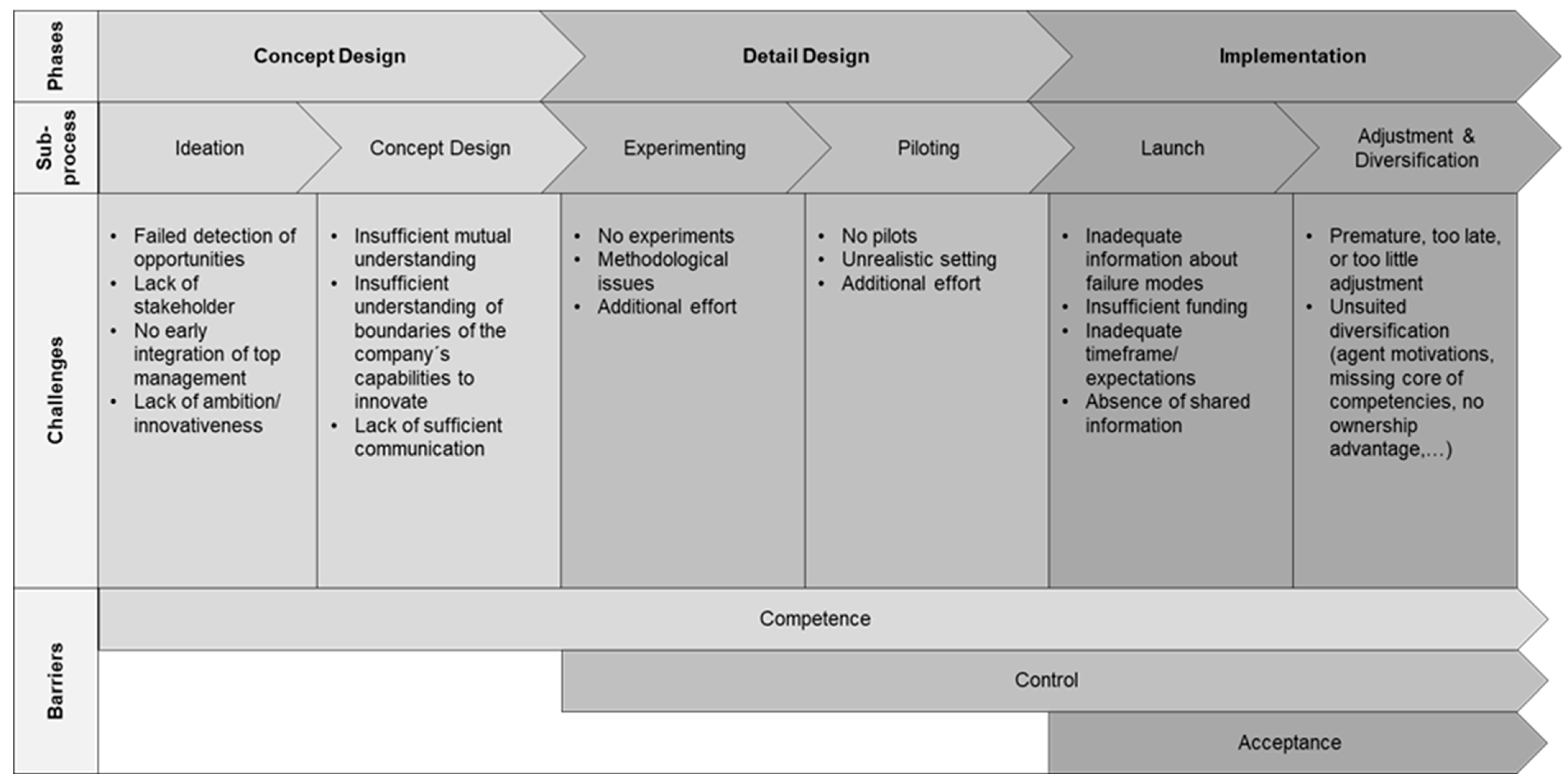Implementation of Digital Technologies in Construction Companies: Establishing a Holistic Process which Addresses Current Barriers
Abstract
:1. Introduction
- Research Question 1:
- What is the status quo of implementation processes for digital technologies and which barriers are currently highlighted in research?
- Research Question 2:
- What are the current barriers for implementing digital tools in the construction industry?
- Research Question 3:
- How can digital tools be introduced in the future as a holistically optimized process?
2. Qualitative Literature Review to Answer Research Question 1
2.1. Material Retrieval
2.2. Literature Selection
- Less than five pages.
- Grey literature.
- Languages other than English.
- Non-peer-reviewed journals.
- Articles that do not directly relate to the stated keywords.
- Lack of information about the authors etc. or the full text.
2.3. Literature Overview
2.4. Qualitative Literature Analysis
3. Qualitative Expert Interviews to Answer Research Question 2
3.1. Survey Instruments and Adaptation
3.2. Selection of Interviewed Companies
3.3. Results
4. Discussion
5. Conclusions and Future Research
Author Contributions
Funding
Institutional Review Board Statement
Informed Consent Statement
Data Availability Statement
Acknowledgments
Conflicts of Interest
Correction Statement
References
- Chen, X.; Chang-Richards, A.Y.; Pelosi, A.; Jia, Y.; Shen, X.; Siddiqui, M.K.; Yang, N. Implementation of Technologies in the Construction Industry: A Systematic Review. Eng. Constr. Archit. Manag. 2021, 29, 3181–3209. [Google Scholar] [CrossRef]
- Olanipekun, A.O.; Sutrisna, M. Facilitating Digital Transformation in Construction—A Systematic Review of the Current State of the Art. Front. Built Environ. 2021, 7, 660758. [Google Scholar] [CrossRef]
- Singh, V. Digitalization, BIM Ecosystem, and the Future of Built Environment: How Widely Are We Exploring the Different Possibilities? Eng. Constr. Archit. Manag. 2019; ahead-of-print. [Google Scholar] [CrossRef]
- Deutsche Telekom AG. Corporate Communications Baugewerbe 2020/2021—Digitalisierungsindex. Available online: https://www.digitalisierungsindex.de/studie/digitale-transformation-baugewerbe-2021/ (accessed on 4 March 2022).
- Gandhi, P.; Khanna, S.; Ramaswamy, S. Which Industries Are the Most Digital (and Why)? Harv. Bus. Rev. 2016, 1, 45–48. [Google Scholar]
- Bajpai, A.; Misra, S.C. Barriers to Implementing Digitalization in the Indian Construction Industry. Int. J. Qual. Reliab. Manag. 2021, 39, 2438–2464. [Google Scholar] [CrossRef]
- Jin, R.; Zou, Y.; Gidado, K.; Ashton, P.; Painting, N. Scientometric Analysis of BIM-Based Research in Construction Engineering and Management. Eng. Constr. Archit. Manag. 2019, 26, 1750–1776. [Google Scholar] [CrossRef]
- Hu, W.; Dong, J.; Hwang, B.; Ren, R.; Chen, Z. A Scientometrics Review on City Logistics Literature: Research Trends, Advanced Theory and Practice. Sustainability 2019, 11, 2724. [Google Scholar] [CrossRef]
- Page, M.J.; McKenzie, J.E.; Bossuyt, P.M.; Boutron, I.; Hoffmann, T.C.; Mulrow, C.D.; Shamseer, L.; Tetzlaff, J.M.; Akl, E.A.; Brennan, S.E.; et al. The PRISMA 2020 Statement: An Updated Guideline for Reporting Systematic Reviews. BMJ 2021, 372, n71. [Google Scholar] [CrossRef] [PubMed]
- Snyder, H. Literature Review as a Research Methodology: An Overview and Guidelines. J. Bus. Res. 2019, 104, 333–339. [Google Scholar] [CrossRef]
- Cerchione, R.; Esposito, E. A Systematic Review of Supply Chain Knowledge Management Research: State of the Art and Research Opportunities. Int. J. Prod. Econ. 2016, 182, 276–292. [Google Scholar] [CrossRef]
- Arvianto, A.; Sopha, B.M.; Asih, A.M.S.; Imron, M.A. City Logistics Challenges and Innovative Solutions in Developed and Developing Economies: A Systematic Literature Review. Int. J. Eng. Bus. Manag. 2021, 13, 184797902110397. [Google Scholar] [CrossRef]
- Salim, H.K.; Stewart, R.A.; Sahin, O.; Dudley, M. Drivers, Barriers and Enablers to End-of-Life Management of Solar Photovoltaic and Battery Energy Storage Systems: A Systematic Literature Review. J. Clean. Prod. 2019, 211, 537–554. [Google Scholar] [CrossRef]
- Vilela, J.; Castro, J.; Martins, L.E.G.; Gorschek, T. Integration between Requirements Engineering and Safety Analysis: A Systematic Literature Review. J. Syst. Softw. 2017, 125, 68–92. [Google Scholar] [CrossRef]
- Hosseini, M.R.; Martek, I.; Zavadskas, E.K.; Aibinu, A.A.; Arashpour, M.; Chileshe, N. Critical Evaluation of Off-Site Construction Research: A Scientometric Analysis. Autom. Constr. 2018, 87, 235–247. [Google Scholar] [CrossRef]
- Oraee, M.; Hosseini, M.R.; Papadonikolaki, E.; Palliyaguru, R.; Arashpour, M. Collaboration in BIM-Based Construction Networks: A Bibliometric-Qualitative Literature Review. Int. J. Proj. Manag. 2017, 35, 1288–1301. [Google Scholar] [CrossRef]
- Xiang, C.; Wang, Y.; Liu, H. A Scientometrics Review on Nonpoint Source Pollution Research. Ecol. Eng. 2017, 99, 400–408. [Google Scholar] [CrossRef]
- Bosch-Sijtsema, P.; Claeson-Jonsson, C.; Johansson, M.; Roupe, M. The Hype Factor of Digital Technologies in AEC. Constr. Innov. 2021, 21, 899–916. [Google Scholar] [CrossRef]
- Nwaogu, J.M.; Chan, A.P.C.; Naslund, J.A.; Hon, C.K.H.; Belonwu, C.; Yang, J. Exploring the Barriers to and Motivators for Using Digital Mental Health Interventions among Construction Personnel in Nigeria: Qualitative Study. JMIR Form. Res. 2021, 5, e18969. [Google Scholar] [CrossRef]
- Reyes, P.; Suresh, S.; Renukappa, S. The Adoption of Big Data Concepts for Sustainable Practices Implementation in the Construction Industry. In Proceedings of the Proceedings—11th IEEE/ACM International Conference on Utility and Cloud Computing Companion, UCC Companion 2018, Zurich, Switzerland, 17–20 December 2018; pp. 341–348. [Google Scholar]
- Tabatabaee, S.; Mohandes, S.R.; Ahmed, R.R.; Mahdiyar, A.; Arashpour, M.; Zayed, T.; Ismail, S. Investigating the Barriers to Applying the Internet-of-Things-Based Technologies to Construction Site Safety Management. Int. J. Environ. Res. Public. Health 2022, 19, 868. [Google Scholar] [CrossRef]
- Atkinson, L.; Amoako-Attah, J.; B-Jahromi, A. Government’s Influence on the Implementation of BIM. In Proceedings of the Computing in Civil and Building Engineering—Proceedings of the 2014 International Conference on Computing in Civil and Building Engineering, Orlando, FL, USA, 23–25 June 2014; pp. 520–527. [Google Scholar]
- Bew, M.; Underwood, J.; Wix, J.; Storer, G. Going BIM in a Commercial World; Zarli, A., Scherer, R., Eds.; EWORK AND EBUSINESS IN ARCHITECTURE, ENGINEERING AND CONSTRUCTION; Taylor & Francis: London, UK, 2009; pp. 139–150. [Google Scholar]
- Jin, R.; Hancock, C.M.; Tang, L.; Wanatowski, D. BIM Investment, Returns, and Risks in China’s AEC Industries. J. Constr. Eng. Manag. 2017, 143, 12. [Google Scholar] [CrossRef]
- Li, Q.; Gu, L.J. Building Information Modeling (BIM) Should Be Promoted in Construction Firm. In Proceedings of the 2nd Global Conference on Civil, Structural and Environmental Engineering, GCCSEE 2013, Volumes 838–841. Shenzhen, China, 28–29 September 2013. [Google Scholar]
- Smith, P. BIM Implementation—Global Strategies. Procedia Eng. 2014, 85, 482–492. [Google Scholar] [CrossRef]
- Dainty, A.; Leiringer, R.; Fernie, S.; Harty, C. BIM and the Small Construction Firm: A Critical Perspective. Build. Res. Inf. 2017, 45, 696–709. [Google Scholar] [CrossRef]
- Zou, Y.; Kiviniemi, A.; Jones, S.W. A Review of Risk Management through BIM and BIM-Related Technologies. Saf. Sci. 2017, 97, 88–98. [Google Scholar] [CrossRef]
- Hautala, K.; Järvenpää, M.-E.; Pulkkinen, P. Digitalization Transforms the Construction Sector throughout Asset’s Life-Cycle from Design to Operation and Maintenance. Stahlbau 2017, 86, 340–345. [Google Scholar] [CrossRef]
- Zuo, J. The Study on Optimized Program of Landscape Engineering Based on BIM Technology. In Proceedings of the 1st EAI International Conference on Multimedia Technology and Enhanced Learning, Inner Mongolia, China, 13–15 August 2016; EAI: Inner Mongolia, China, 2017. [Google Scholar]
- Ghosh, A.; Edwards, D.J.; Hosseini, M.R.; Al-Ameri, R.; Abawajy, J.; Thwala, W.D. Real-Time Structural Health Monitoring for Concrete Beams: A Cost-Effective ‘Industry 4.0’ Solution Using Piezo Sensors. Int. J. Build. Pathol. Adapt. 2021, 39, 283–311. [Google Scholar] [CrossRef]
- Hassan Ibrahim, N. Reviewing the Evidence: USE of Digital Collaboration Technologies in Major Building and Infrastructure Projects. J. Inf. Technol. Constr. 2013, 18, 40–63. [Google Scholar]
- Oke, A.E.; Aghimien, D.O.; Aigbavboa, C.O.; Koloko, N. Challenges of Digital Collaboration in the South African Construction Industry. In Proceedings of the International Conference on Industrial Engineering and Operations Management, Bandung, Indonesia, 6–8 March 2018; pp. 2472–2482. [Google Scholar]
- Sepasgozar, S.M.E. Digital Technology Utilisation Decisions for Facilitating the Implementation of Industry 4.0 Technologies. Constr. Innov. 2021, 21, 476–489. [Google Scholar] [CrossRef]
- Lokshina, I.V.; Greguš, M.; Thomas, W.L. Application of Integrated Building Information Modeling, Iot And. Procedia Comput. Sci. 2019, 160, 497–502. [Google Scholar] [CrossRef]
- Singh, P. Blockchain Based Security Solutions with IoT Application in Construction Industry. IOP Conf. Ser. Earth Environ. Sci. 2020, 614, 012052. [Google Scholar] [CrossRef]
- Elnabawi, M.H.; Hamza, N. Investigating Building Information Model (BIM) to Building Energy Simulation (BES): Interoperability and Simulation Results. IOP Conf. Ser. Earth Environ. Sci. 2019, 397, 012013. [Google Scholar] [CrossRef]
- Jia, J.; Dou, S.; Yang, S.; Wu, Y.; Cao, F.; Li, B.; Cui, H. Study on the Application Framework of BIM in the Life Cycle Management of Offshore Wind Farms. In Proceedings of the International Offshore and Polar Engineering Conference, Honolulu, HI, USA, 16–21 June 2019; Volume 1, pp. 513–520. [Google Scholar]
- Afzal, M.; Shafiq, M.T.; Al Jassmi, H. Improving Construction Safety with Virtual-Design Construction Technologies—A Review. J. Inf. Technol. Constr. 2021, 26, 319–340. [Google Scholar] [CrossRef]
- Rey, R.O.; de Melo, R.R.S.; Costa, D.B. Design and Implementation of a Computerized Safety Inspection System for Construction Sites Using UAS and Digital Checklists—Smart Inspecs. Saf. Sci. 2021, 143, 105430. [Google Scholar] [CrossRef]
- Pahomova, E.G.; Monastyrev, P.V.; Mishchenko, E.S.; Yezerskiy, V.A.; Ivanov, I.A.; Balthazar, A.D. House-Building Analysis When Using Additive Technologies:Classification, Advantages and Disadvantages. J. Appl. Eng. Sci. 2019, 17, 449–456. [Google Scholar] [CrossRef]
- Chowdhury, T.; Adafin, J.; Wilkinson, S. Review of Digital Technologies to Improve Productivity of New Zealand Construction Industry. J. Inf. Technol. Constr. 2019, 24, 569–587. [Google Scholar] [CrossRef]
- Hwang, B.-G.; Ngo, J.; Her, P.W.Y. Integrated Digital Delivery: Implementation Status and Project Performance in the Singapore Construction Industry. J. Clean. Prod. 2020, 262, 121396. [Google Scholar] [CrossRef]
- Won, D.; Hwang, B.-G.; Binte Mohd Samion, N.K. Cloud Computing Adoption in the Construction Industry of Singapore: Drivers, Challenges, and Strategies. J. Manag. Eng. 2022, 38, 05021017. [Google Scholar] [CrossRef]
- Singh, A.; Misra, S.C. Identifying Challenges in the Adoption of Industry. In Progress in Advanced Computing and Intelligent Engineering; Springer: Singapore, 2021; Volume 1198. [Google Scholar]
- Koscheyev, V.; Hakimov, A. Russian Practice of Using Digital Technologies in Public Procurement Management in the Construction Industry. IOP Conf. Ser. Mater. Sci. Eng. 2019, 497, 012009. [Google Scholar] [CrossRef]
- Turkova, V.N.; Archipova, A.N.; Fedorovna, Z.G. Digital Transformation of the Russian Construction Industry. IOP Conf. Ser. Mater. Sci. Eng. 2020, 880, 012083. [Google Scholar] [CrossRef]
- Olawumi, T.O.; Chan, D.W.M. Developing Project Evaluation Models for Smart Sustainable Practices Implementation in Construction Projects: A Comparative Study between Nigeria and Hong Kong. Eng. Constr. Archit. Manag. 2021, 29, 1522–1552. [Google Scholar] [CrossRef]
- Awuzie, B.; Monyane, T. Achieving Sustainable Construction in South Africa through Digitalization: An Exploratory Study. In Proceedings of the 22nd International Conference on Advancement of Construction Management and Real Estate, CRIOCM 2017, Victoria, Australia, 20–23 November 2017; pp. 935–942. [Google Scholar]
- Sepasgozar, S.; Davis, S. Construction Technology Adoption Cube: An Investigation on Process, Factors, Barriers, Drivers and Decision Makers Using NVivo and AHP Analysis. Buildings 2018, 8, 74. [Google Scholar] [CrossRef]
- Ramilo, R.; Embi, M.R.B. Critical Analysis of Key Determinants and Barriers to Digital Innovation Adoption among Architectural Organizations. Front. Archit. Res. 2014, 3, 431–451. [Google Scholar] [CrossRef]
- Döring, N.; Bortz, J.; Pöschl, S.; Werner, C.S.; Schermelleh-Engel, K.; Gerhard, C.; Gäde, J.C. Forschungsmethoden und Evaluation in den Sozial- und Humanwissenschaften, 2016th ed.; Springer: Berlin/Heidelberg, Germany, 2015; ISBN 978-3-642-41088-8. [Google Scholar]
- Jonker, J.; Pennink, B. The Essence of Research Methodology: A Concise Guide for Master and PhD Students in Management Science, 2010th ed.; Springer: Berlin/Heidelberg, Germany; Dordrecht, The Netherlands; London, UK; New York, NY, USA, 2010; ISBN 978-3-540-71658-7. [Google Scholar]
- Reichertz, J. Empirische Sozialforschung und soziologische Theorie. In Handbuch Methoden der empirischen Sozialforschung; Baur, N., Blasius, J., Eds.; Springer Fachmedien: Wiesbaden, Germany, 2019; pp. 31–48. ISBN 978-3-658-21308-4. [Google Scholar]
- Saunders, M.; Lewis, P.; Thornhill, A. Research Methods for Business Students, 8th ed.; Pearson Education Limited: New York, NY, USA, 2019; ISBN 978-1-292-20878-7. [Google Scholar]
- Baur, N.; Blasius, J. Methoden der empirischen Sozialforschung—Ein Überblick. In Handbuch Methoden der Empirischen Sozialforschung; Baur, N., Blasius, J., Eds.; Springer Fachmedien: Wiesbaden, Germany, 2019; pp. 1–28. ISBN 978-3-658-21308-4. [Google Scholar]
- Kaya, M. Verfahren der Datenerhebung. In Methodik der Empirischen Forschung; Albers, S., Klapper, D., Konradt, U., Walter, A., Wolf, J., Eds.; Gabler Verlag: Wiesbaden, Germany, 2009; pp. 49–64. ISBN 978-3-322-96406-9. [Google Scholar]
- Klandt, H.; Heidenreich, S. Empirische Forschungsmethoden in der Betriebswirtschaftslehre: Von der Forschungsfrage zum Untersuchungsdesign, eine Einführung; De Gruyter Oldenbourg: Berlin, Germany, 2017; ISBN 978-3-486-70972-8. [Google Scholar]
- Schnell, R.; Hill, P.B.; Esser, E. Methoden Der Empirischen Sozialforschung; De Gruyter Oldenbourg: Berlin, Germany; Boston, MA, USA, 2018; ISBN 978-3-11-057732-7. [Google Scholar]
- Bogner, A.; Littig, B.; Menz, W. Experteninterviews: Theorien, Methoden, Anwendungsfelder; VS Verlag für Sozialwissenschaften: Wiesbaden, Germany, 2009; ISBN 978-3-531-16259-1. [Google Scholar]
- Helfferich, C. Leitfaden- und Experteninterviews. In Handbuch Methoden der Empirischen Sozialforschung; Baur, N., Blasius, J., Eds.; Springer Fachmedien: Wiesbaden, Germany, 2019; pp. 669–686. ISBN 978-3-658-21308-4. [Google Scholar]
- Kaiser, R. Qualitative Experteninterviews: Konzeptionelle Grundlagen und praktische Durchführung; Springer VS: Wiesbaden, Germany, 2021; ISBN 978-3-658-30254-2. [Google Scholar]
- Neyer, F.J.; Felber, J.; Gebhardt, C. Kurzskala Technikbereitschaft (TB, technology commitment). Zs. Soz. Items Skalen ZIS 2016. [Google Scholar] [CrossRef]
- Sinkovics, R. Technophobie. Zs. Soz. Items Skalen ZIS 2003. [Google Scholar] [CrossRef]
- Neyer, F.J.; Felber, J.; Gebhardt, C. Entwicklung Und Validierung Einer Kurzskala Zur Erfassung von Technikbereitschaft. Diagnostica 2012, 58, 87–99. [Google Scholar] [CrossRef]
- Linden, M. Die 50 Größten Bauunternehmen. Available online: https://www.bauindustrie.de/zahlen-fakten/die-50-groessten-bauunternehmen (accessed on 4 March 2022).
- Geissdoerfer, M.; Vladimirova, D.; Evans, S. Sustainable Business Model Innovation: A Review. J. Clean. Prod. 2018, 198, 401–416. [Google Scholar] [CrossRef]
- Geissdoerfer, M.; Savaget, P.; Evans, S. The Cambridge Business Model Innovation Process. Procedia Manuf. 2017, 8, 262–269. [Google Scholar] [CrossRef]
- Aghimien, D.; Aigbavboa, C.; Oke, A. Digitalisation for Effective Construction Project Delivery in South Africa; Coventry University: Coventry, UK, 5–6 July 2018. [Google Scholar]
- Abu-Reishah, L.; Hiyassat, M.A. The Severity of Design-Construction Interface Risks in Jordanian Construction Industry. Int. J. Constr. Manag. 2021, 1–9. [Google Scholar] [CrossRef]
- Keerthanaa, K.; Shanmugapriya, S. Role of Interface Management in Construction Industry. Int. Res. J. Eng. Technol. IRJET 2017, 4, 1217–1220. [Google Scholar]
- Kudryavtseva, V.A.; Nikishina, O.V.; Vasileva, N.V. Features of Digital Transformation in the Construction Industry. IOP Conf. Ser. Mater. Sci. Eng. 2020, 880, 012080. [Google Scholar] [CrossRef]









| No. | Logical Statement | Search String | Results “Web of Science” | Results “Scopus” | Total |
|---|---|---|---|---|---|
| 1 | Barriers regarding digital technologies in the construction industry. | =(“DIGITAL TECHNOLOGIES” AND “CONSTRUCTION INDUSTRY” AND (“BARRIERS” OR “OBSTACLES” OR “DIFFICULTIES”)) | 6 | 18 | 24 |
| 2 | Implementation process of digital technologies in construction industry | =(“DIGITAL TECHNOLOGIES” AND “CONSTRUCTION INDUSTRY” AND (“IMPLEMENTATION” OR “IMPLEMENTATION PROCESS”)) | 14 | 57 | 71 |
| 3 | Barriers regarding the implementation process of digital technologies in the construction industry. | =(“DIGITAL TECHNOLOGIES” AND “CONSTRUCTION INDUSTRY” AND (“IMPLEMENTATION PROCESS” OR “IMPLEMENTATION”) AND (“BARRIERS” OR “OBSTACLES” OR “DIFFICULTIES”)) | 4 | 10 | 14 |
| Total | 24 | 85 | 109 | ||
| No. | Authors | Year | Title | No. of Citations |
|---|---|---|---|---|
| 1 | Zou, Y., Kiviniemi, A., Jones, S.W. | 2017 | A review of risk management through BIM and BIM-related technologies | 141 |
| 2 | Smith, P. | 2014 | BIM implementation—Global strategies | 125 |
| 3 | Dainty, A., Leiringer, R., Fernie, S., Harty, C. | 2017 | BIM and the small construction firm: a critical perspective | 87 |
| 4 | Jin, R., Hancock, C.M., Tang, L., Wanatowski, D. | 2017 | BIM investment, returns, and risks in China’s AEC Industries | 55 |
| 5 | Hassan Ibrahim, N. | 2013 | Reviewing the evidence: Use of digital collaboration technologies in major building and infrastructure projects | 44 |
| 6 | Jin, R., Zou, Y., Gidado, K., Ashton, P., Painting, N. | 2019 | Scientometric analysis of BIM-based research in construction engineering and management | 34 |
| 7 | Lokshina, I.V., Greguš, M., Thomas, W.L. | 2019 | Application of integrated building information modeling, IoT and blockchain technologies in system design of a smart building | 25 |
| 8 | Oke, A.E., Aghimien, D.O., Aigbavboa, C.O., Koloko, N. | 2018 | Challenges of digital collaboration in the South African construction industry | 15 |
| 9 | Ghosh, A., Edwards, D.J., Hosseini, M.R., Al-Ameri, R., Abawajy, J., Thwal, W.D. | 2021 | Real-time structural health monitoring for concrete beams: a cost-effective ‘Industry 4.0′ solution using piezo sensors | 12 |
| 10 | Sepasgozar, S.M.E. | 2020 | Digital technology utilisation decisions for facilitating the implementation of Industry 4.0 technologies | 9 |
| Cluster | Statement | Origin * |
|---|---|---|
| Acceptance | (1.1) The company is always open towards digital technologies | A |
| (1.2) Digital technologies are quickly adopted and integrated within the company | A | |
| (1.3) The company is always interested in using the latest digital technologies | A | |
| (1.4) If there were the possibility, the company would use even more digital technologies | A | |
| (1.5) Digital technologies are well accepted in the company | B | |
| (1.6) Digital technologies make work easier for employees in the company | B | |
| (1.7) Digital technologies create added value for the company | B | |
| Competence | (2.1) Employees mostly do not fail in the use of digital technologies | A |
| (2.2) Dealing with digital technologies does not usually lead to employees being excessively demanded | A | |
| (2.3) Employees use digital technologies correctly without causing harm | A | |
| (2.4) Dealing with digital technologies does not lead to a loss of control and self- doubt among employees | A | |
| (2.5) The use of digital technologies leads to uncertainty | B | |
| (2.6) Digital technologies cause conflicts in the company | B | |
| (2.7) Other companies are more practised in the use of digital technologies | B | |
| (2.8) The use of digital technologies leads to frustration | B | |
| (2.9) The use of digital technologies leads to nervousness | B | |
| (2.10) There is uncertainty in the introduction of digital technologies | B | |
| Control | (3.1) The implementation of digital technologies depends on individual employees | A |
| (3.2) The successful use of digital technologies depends on individual employees | A | |
| (3.3) Only little outside support can be provided for the use of digital technologies | A | |
| (3.4) The use of digital technologies creates ownership among employees | A | |
| (3.5) Digital technologies reduce personal contact in the company | B | |
| (3.6) The use of digital technologies should be mandatory | B | |
| (3.7) Trust in digital technologies is not entirely present | B | |
| (3.8) The use of digital technologies should be autonomous | B |
Disclaimer/Publisher’s Note: The statements, opinions and data contained in all publications are solely those of the individual author(s) and contributor(s) and not of MDPI and/or the editor(s). MDPI and/or the editor(s) disclaim responsibility for any injury to people or property resulting from any ideas, methods, instructions or products referred to in the content. |
© 2022 by the authors. Licensee MDPI, Basel, Switzerland. This article is an open access article distributed under the terms and conditions of the Creative Commons Attribution (CC BY) license (https://creativecommons.org/licenses/by/4.0/).
Share and Cite
Schnell, P.; Haag, P.; Jünger, H.C. Implementation of Digital Technologies in Construction Companies: Establishing a Holistic Process which Addresses Current Barriers. Businesses 2023, 3, 1-18. https://doi.org/10.3390/businesses3010001
Schnell P, Haag P, Jünger HC. Implementation of Digital Technologies in Construction Companies: Establishing a Holistic Process which Addresses Current Barriers. Businesses. 2023; 3(1):1-18. https://doi.org/10.3390/businesses3010001
Chicago/Turabian StyleSchnell, Peter, Phillip Haag, and Hans Christian Jünger. 2023. "Implementation of Digital Technologies in Construction Companies: Establishing a Holistic Process which Addresses Current Barriers" Businesses 3, no. 1: 1-18. https://doi.org/10.3390/businesses3010001
APA StyleSchnell, P., Haag, P., & Jünger, H. C. (2023). Implementation of Digital Technologies in Construction Companies: Establishing a Holistic Process which Addresses Current Barriers. Businesses, 3(1), 1-18. https://doi.org/10.3390/businesses3010001





